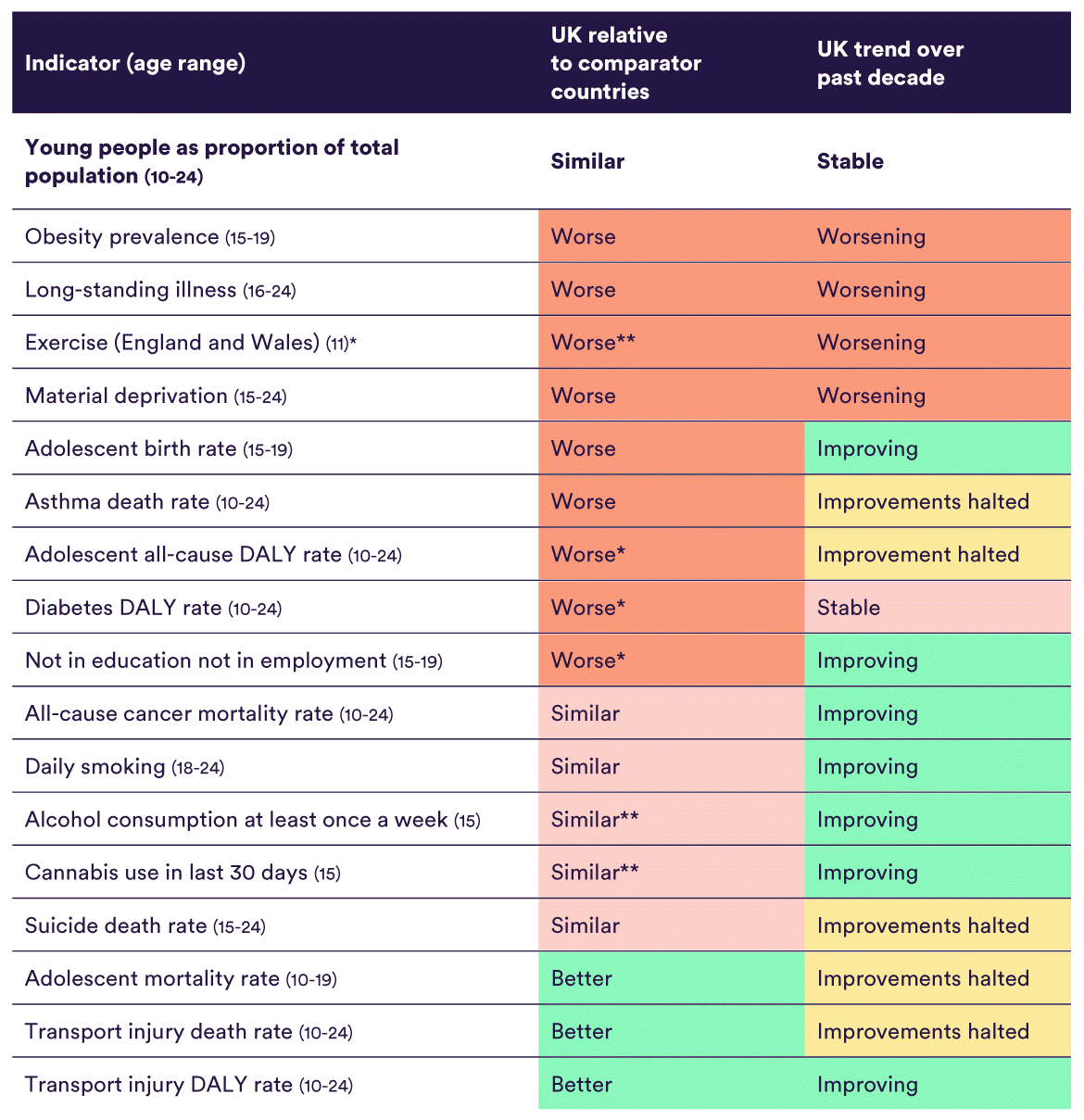Young people aged 10–24 make up approximately a fifth of the population of most high-income countries and there are strong health and economic arguments for improving their health outcomes. This report summarises how 17 key indicators of the health and wellbeing of young people aged 10–24 vary in a selection of 19 similar high-income countries both within and outside of Europe.
The report, published with the Association for Young People's Health, provides an indication of where health outcomes for adolescents and young adults in the United Kingdom (UK) could be improved. Despite some successes, the UK’s performance on the 17 key health and wellbeing indicators highlighted in this report often lags behind that of the other 18 countries included in the analysis and there is much room for improvement.
Key findings
The UK is performing least well in the following areas. It has:
- the highest rates of obesity for 15- to 19-year-olds among 14 European comparator countries
- the highest inequalities in obesity prevalence between the richest and poorest, apart from Finland, in countries where data are available
- the highest rate of young people aged 16–24 living with a longstanding condition among 14 European comparator countries apart from Finland and Sweden
- low rates of engagement in exercise by 11-year-olds in England and Wales
- the highest asthma death rate for those aged 10–24 among all 19 countries apart from Australia, New Zealand and the United States (US)
- the highest rate of adolescent girls aged 15–19 giving birth among all 19 countries apart from New Zealand and the US
- a high percentage of young people aged 15-19 not in education, employment or training (NEET)
- high rates of severe material deprivation among 15- to 24-year-olds
- a high burden-of-disease rate for all causes, and in particular for type 1 diabetes.
In addition, time trends within the UK suggest that some of these indicators are getting worse, including obesity, longstanding illness, severe material deprivation and exercise levels. Initial improvements in the number of asthma deaths have also stalled in the past few years.
The UK is performing in the middle of the group of similar high-income countries for several indicators, including cancer mortality, suicide death rates and health-related behaviours such as smoking, alcohol consumption and cannabis use. Trends in health-related behaviours have been going in a positive direction in the UK in recent years, with falls in smoking rates and
rates for lifetime use of cannabis.
Areas where the UK is performing well in this international comparison include:
- low rates of road traffic injury deaths
- low all-cause mortality.
However, taking a closer look at the time trends in these more positive areas, it appears that initial improvements may have stalled. For example, decreases in mortality rates levelled out around 2013 and there is a concern that they may be getting worse. In addition, stark inequalities exist in road traffic injury death between those from the richest and those from the poorest backgrounds.
The table below provides a summary of how the UK compares with the 18 comparator countries and the UK trend over the past decade for each of the 17 indicators.
Find out more about our use of Disability Adjusted Life Years (DALYs) to understand young people's in our Explainer:
Conclusion
The international comparisons in this report have provided us with important messages about the state of health and wellbeing of young people aged 10–24 in the UK when compared with their counterparts in 18 other high-income countries, across 17 key indicators. Although there are some positive findings, the UK’s performance on many indicators for this age group lags behind that of similar high-income countries, and there is much room for improvement. But some successes show that improvement is possible.
The UK performs less well than the comparator countries particularly in terms of the support given to young people with long-term health conditions to manage their care. Adolescents and young adults in the UK are more likely to die from asthma, and more likely to be obese and overweight, than their counterparts in the comparator countries. The burden of disability in adolescents, including from long-term conditions such as diabetes, is also greater in the UK.
This is happening at a time when more and more adolescents and young adults are making better choices about their health than at almost any other time in living memory. By contrast, health services, professionals and policymakers are failing to live up to their part of the bargain, at best failing to keep pace with comparable countries, and at worst, falling behind. There are early signs already that we are putting decades of progress in young people’s health in jeopardy. Our international comparisons tell us that we can, and must, do better.
There is an urgent need to prioritise and invest in the 10–24 age group to improve young people’s current health outcomes and for a future healthy adult population. To improve the state of young people’s health in the UK, we must take an approach across three broad categories: policy initiatives focusing on young people; the improvement of everyday practice; and specific action to reduce health inequalities.
Partners

